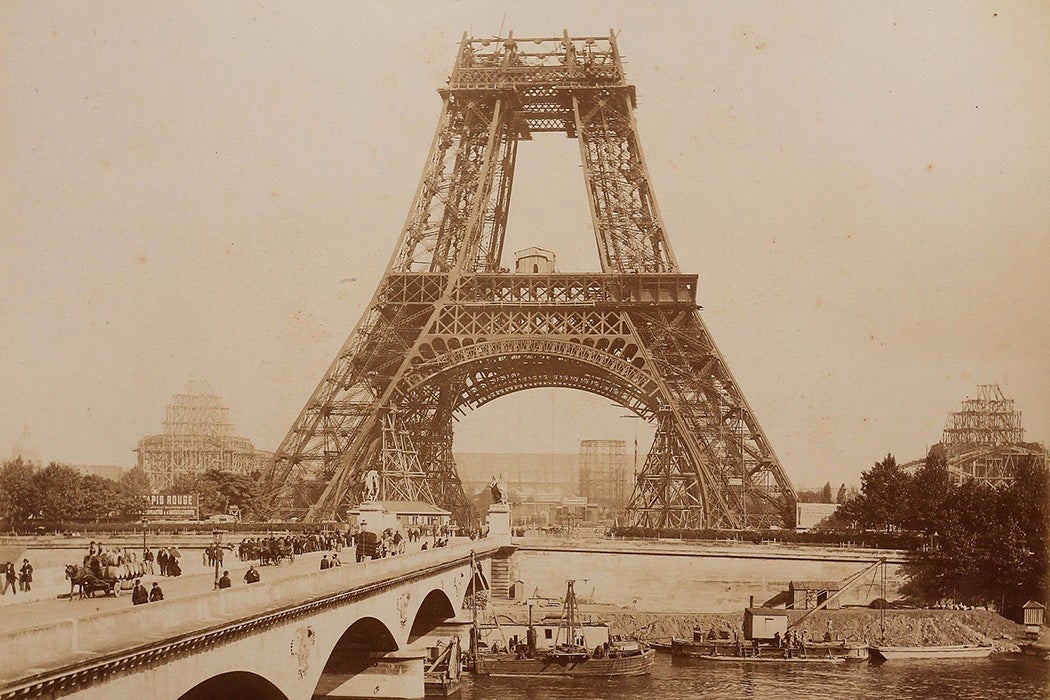When construction of the now-iconic Eiffel Tower began in 1887, many Parisians were less than enamored by the project-in-progress. In fact, some were outright hostile towards it. But perhaps the Eiffel Tower’s greatest rejection came from the people who held the most authority on what worked aesthetically for the city and what didn’t: Parisian artists and writers. To them, the Eiffel Tower, spindly and bare like a skeleton, posed an unforgivable threat to the city’s sacred reputation as a lush, beatific urban ideal for nurturing creative minds. Unlike the Lost Generation of the 1920s, their spiritual descendants, the late-nineteenth-century intellectuals didn’t feel “inspired” by the looming presence over their city. The unusual structure hadn’t yet achieved its modern status, which William Thompson describes as “the acknowledged foremost universal symbol of Paris and France.”
French painter Ernest Meissonier, the first president of the Société Nationale des Beaux-Arts, was one such rigid Anti-Tower individual. So, too, was Charles Garnier, architect of the Paris Opera. Academic painter William-Adolphe Bouguereau. Poets Sully Prudhomme and Leconte de Lisle. The composer Charles Gounod. All saw the Eiffel Tower as a humiliation and a mockery.
On February 14, 1887, this organized circle published a letter of protest against the tower, asserting the validity of their artistic sense over that of engineers, asking in fiery earnest:
Will the city of Paris continue to associate itself with the baroque and mercantile fancies of a builder of machines thereby making itself irreparably ugly and bringing dishonor to itself? Because the Eiffel Tower that even the commercial Americans didn’t want, will without a doubt dishonor Paris.
These petitions and protests, however well-composed and well-executed they were, fell flat. Eponymous civil engineer Gustave Eiffel firmly stood his ground. In an interview conducted with the Les Temps newspaper on the same day as the manifesto’s publication, he queried
What are the reasons given by the artists for protesting against the maintenance of the tower? How useless, how monstrous! What a horror! We’ll talk about usefulness later. Let us concern ourselves, for the moment, only with the aesthetic merit, on which the artists are more particularly competent. I would like to know on what they base their judgment. Because, mark it, sir, my tower, nobody saw it and nobody, before it was built, could say what it will be.
Weekly Newsletter
The Eiffel Tower defiantly went up, completed in 1889. Yet many members of the avant-garde remained stubbornly resistant to its charms. According to Eiffel Tower’s biographer Roland Barthes, French writer Guy de Maupassant frequently dined in one of the tower’s restaurants, not because he was particularly fond of the cuisine on offer, but because, being inside the structure was the only way for a Parisian to avoid having to look at it. And according to Thompson, Maupassant was also known to occasionally bash the tower in his writing:
Rarely naming the structure itself, Maupassant preferred to concoct elaborate, at times scathing descriptions which would hopefully convince the reader of the grotesqueness and inutility of the Tower.
Today, the Eiffel Tower serves as the backdrop for the must-have photo-op for tourists who flock to the City of Lights, and the locals have peacefully accepted the monument as an immovable fixture in their everyday lives. Sometimes an architectural triumph needs a couple of generations for people to warm up to it.







